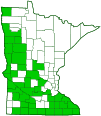Great Plains ladies’ tresses
(Spiranthes magnicamporum)
Conservation • Wetland • Description • Habitat • Ecology • Use • Distribution • Taxonomy
Description |
||
Great Plains ladies’ tresses is a 4¾″ to 15″ tall, erect, perennial forb that rises on s single stalk from a tight cluster of fleshy roots. There are 2 or 3 basal leaves which are usually withered by the time the plant is in bloom. They are ascending, inversely lance-shaped to linear lance-shaped, 4″ to 5½″ long, and 5 ⁄16″ to ⅜″ wide. The margins are untoothed. The stems are erect, unbranched, and leafless except for a few scale-like, sheathing, typically overlapping bracts below the inflorescence. The inflorescence is a pair of intertwined, tightly spiraling, ¾″ to 2⅓″ long flower spikes at the top of the stem with 20 to 40 individual flowers. The flowers on each spike are arranged in spirals of 3 or 4 flowers per cycle of spiral. The spirals are not evident due to the intertwining of the two spikes. The spikes are light green and moderately hairy. Each flower is subtended by a scale-like, egg-shaped to lance-shaped bract. The flowers are about ½″ long and abruptly nodding at the base. There are 3 white to ivory petals and 3 similar petal-like sepals. The upper 2 petals converge with but do not fuse with the upper sepal to form a hood over the united filaments and style (column). The tips of the upper petals and sepal curve upward slightly. The lower petal forms an egg-shaped lip that arches strongly downward. The central portion of the lip is yellowish and is not constricted near the middle. The lip is crisped at the tip. The lateral 2 sepals are linear- lance-shaped, slightly spreading, then recurving, often ascending above the flower, like a pair of cow’s horns. The margins of the lateral sepals are rolled inward. The flowers are almond-scented. |
||
Height |
||
4¾″ to 15″ |
||
Flower Color |
||
White to ivory |
||
Similar Species |
||
Sphinx ladies’ tresses (Spiranthes incurva) stem leaves are often present at flowering. The lateral 2 sepals are straight or slightly spreading, not recurving, not shaped like a pair of cow’s horns. The central portion of the lower lip is constricted toward the middle. The flowers not scented. |
||
Habitat |
||
Dry to wet. Prairies, woods, fens, pastures. |
||
Ecology |
||
Flowering |
||
September to October |
||
Pests and Diseases |
||
|
||
Use |
||
|
||
Distribution |
||||
|
Sources |
|||
| 4/28/2023 | ||||
Nativity |
||||
Native |
||||
Occurrence |
||||
|
||||
Taxonomy |
|||
| Kingdom | Plantae (Plants) | ||
| Division | Tracheophyta (Vascular Plants) | ||
| Subdivision | Spermatophytina (Seed Plants) | ||
| Class | Liliopsida (Monocots) | ||
Order |
Asparagales (Agaves, Orchids, Irises, and Allies) | ||
Family |
Orchidaceae (orchids) | ||
| Subfamily | Orchidoideae (orchidoid orchids) | ||
| Tribe | Cranichideae | ||
| Subtribe | Spiranthinae | ||
Genus |
Spiranthes (ladies’-tresses) | ||
| Species Complex | Spiranthes cernua complex (nodding ladies’ tresses complex) | ||
Subordinate Taxa |
|||
|
|||
Synonyms |
|||
|
|||
Common Names |
|||
Great Plains ladies’ tresses Great Plains ladies’-tresses Great Plains ladiestresses Great Plains lady’s tresses |
|||
Glossary
Bract
Modified leaf at the base of a flower stalk, flower cluster, or inflorescence.
Column
The united filaments and style of an orchid. The structure formed by the united filaments of plants in the Mallow family.
Linear
Long, straight, and narrow, with more or less parallel sides, like a blade of grass.
Sepal
An outer floral leaf, usually green but sometimes colored, at the base of a flower.
Sheath
The lower part of the leaf that surrounds the stem.
Visitor Photos |
|||||
Share your photo of this plant. |
|||||
| This button not working for you? Simply email us at info@MinnesotaSeasons.com. Attach one or more photos and, if you like, a caption. |
|||||
Dan W. Andree |
|||||
Possibly a Great Plains Ladies-tresses... |
|||||
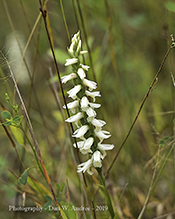 |
|||||
MinnesotaSeasons.com Photos |
|||||
Plant |
|||||
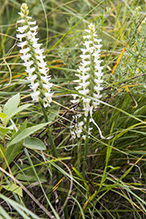 |
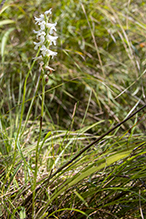 |
||||
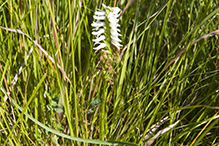 |
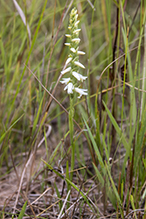 |
||||
Inflorescence |
|||||
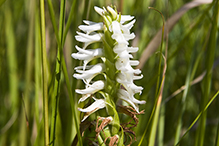 |
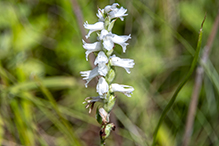 |
||||
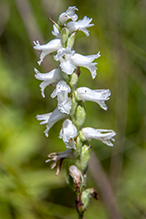 |
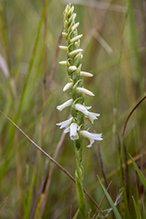 |
||||
Flowers |
|||||
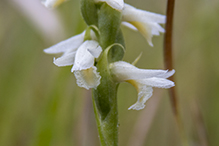 |
|||||

Slideshows |
||
| Spiranthes magnicamporum (Prairie Ladies-Tresses) Allen Chartier |
||
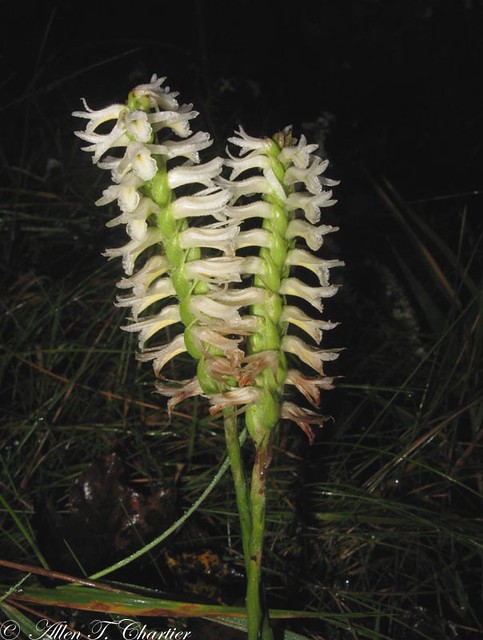
|
||
| Spiranthes magnicamporum GREAT PLAINS LADIES' TRESSES Frank Mayfield |
||
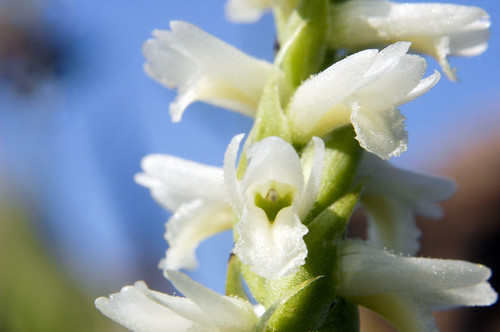
|
||

Visitor Videos |
|||
Share your video of this plant. |
|||
| This button not working for you? Simply email us at info@MinnesotaSeasons.com. Attach a video, a YouTube link, or a cloud storage link. |
|||
Other Videos |
|||

|
Created: Last Updated: © MinnesotaSeasons.com. All rights reserved. |
